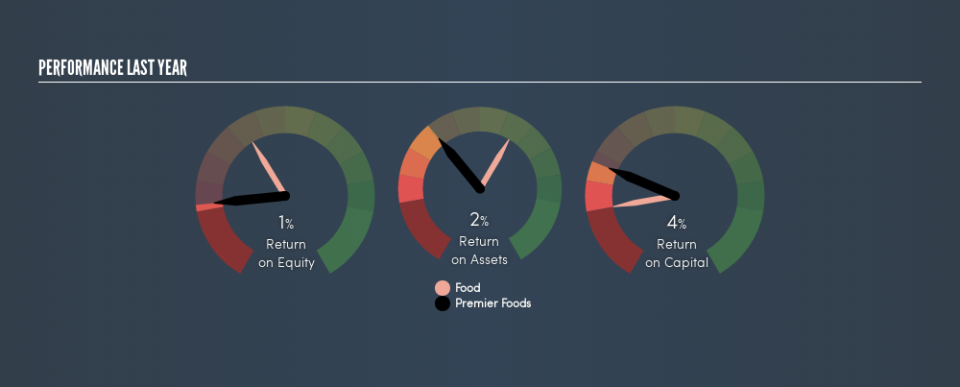Shareholders Should Look Hard At Premier Foods plc’s (LON:PFD) 3.9% Return On Capital

Today we'll evaluate Premier Foods plc (LON:PFD) to determine whether it could have potential as an investment idea. Specifically, we'll consider its Return On Capital Employed (ROCE), since that will give us an insight into how efficiently the business can generate profits from the capital it requires.
Firstly, we'll go over how we calculate ROCE. Second, we'll look at its ROCE compared to similar companies. Then we'll determine how its current liabilities are affecting its ROCE.
Return On Capital Employed (ROCE): What is it?
ROCE is a metric for evaluating how much pre-tax income (in percentage terms) a company earns on the capital invested in its business. All else being equal, a better business will have a higher ROCE. In brief, it is a useful tool, but it is not without drawbacks. Renowned investment researcher Michael Mauboussin has suggested that a high ROCE can indicate that 'one dollar invested in the company generates value of more than one dollar'.
How Do You Calculate Return On Capital Employed?
The formula for calculating the return on capital employed is:
Return on Capital Employed = Earnings Before Interest and Tax (EBIT) ÷ (Total Assets - Current Liabilities)
Or for Premier Foods:
0.039 = UK£75m ÷ (UK£2.1b - UK£229m) (Based on the trailing twelve months to September 2018.)
Therefore, Premier Foods has an ROCE of 3.9%.
View our latest analysis for Premier Foods
Is Premier Foods's ROCE Good?
When making comparisons between similar businesses, investors may find ROCE useful. In this analysis, Premier Foods's ROCE appears meaningfully below the 12% average reported by the Food industry. This performance is not ideal, as it suggests the company may not be deploying its capital as effectively as some competitors. Independently of how Premier Foods compares to its industry, its ROCE in absolute terms is low; especially compared to the ~1.2% available in government bonds. It is likely that there are more attractive prospects out there.
In our analysis, Premier Foods's ROCE appears to be 3.9%, compared to 3 years ago, when its ROCE was 0.01%. This makes us think the business might be improving.
When considering this metric, keep in mind that it is backwards looking, and not necessarily predictive. ROCE can be deceptive for cyclical businesses, as returns can look incredible in boom times, and terribly low in downturns. ROCE is, after all, simply a snap shot of a single year. Since the future is so important for investors, you should check out our free report on analyst forecasts for Premier Foods.
What Are Current Liabilities, And How Do They Affect Premier Foods's ROCE?
Current liabilities are short term bills and invoices that need to be paid in 12 months or less. The ROCE equation subtracts current liabilities from capital employed, so a company with a lot of current liabilities appears to have less capital employed, and a higher ROCE than otherwise. To check the impact of this, we calculate if a company has high current liabilities relative to its total assets.
Premier Foods has total assets of UK£2.1b and current liabilities of UK£229m. Therefore its current liabilities are equivalent to approximately 11% of its total assets. With a very reasonable level of current liabilities, so the impact on ROCE is fairly minimal.
Our Take On Premier Foods's ROCE
Premier Foods has a poor ROCE, and there may be better investment prospects out there. Of course, you might also be able to find a better stock than Premier Foods. So you may wish to see this free collection of other companies that have grown earnings strongly.
If you like to buy stocks alongside management, then you might just love this free list of companies. (Hint: insiders have been buying them).
We aim to bring you long-term focused research analysis driven by fundamental data. Note that our analysis may not factor in the latest price-sensitive company announcements or qualitative material.
If you spot an error that warrants correction, please contact the editor at editorial-team@simplywallst.com. This article by Simply Wall St is general in nature. It does not constitute a recommendation to buy or sell any stock, and does not take account of your objectives, or your financial situation. Simply Wall St has no position in the stocks mentioned. Thank you for reading.

 Yahoo Finance
Yahoo Finance 
